
Related
Ten years ago today, on May 24, 1990, a bomb went off under the driver’s seat of Earth First! activist Judi Bari’s car in Oakland, California. Bari was nearly killed by the bomb — her pelvis literally exploded. The passenger in her car, Earth First!er Darryl Cherney was shell-shocked, but less seriously wounded. Bari and Cherney were on their way to a Redwood Summer organizing event. For months before the bombing, Judi Bari had been uniting loggers and activists in a campaign against the Timber giants of northern California, whose so called cut and run logging practices, Bari said, were destroying not only the forest but the livelihood of whole communities. This bombing was preceded by an aggressive campaign of death threats and harassment against Judi Bari. Nearly killed by the blast, Judy Bari lived permanently disabled and in constant pain until she died in 1997 of breast cancer. [includes rush transcript]
Today, ten years later no one has been apprehended in the bombing. For the past nine years, Darryl Cherney and the estate of Judi Bari have been waiting for a trial date in their federal lawsuit against agents of the FBI and Oakland Police. That date has just been set for Oct 2001.
We turn now to a documentary by Noelle Hanrahan and the Prison Radio Project called “Revolutionary Ecology: The Legacy of Judi Bari,” on this tenth anniversary of her bombing.
Tape:
- Revolutionary Ecology: The Legacy Of Judi Bari
Transcript
AMY GOODMAN: And now we turn to a second story about the FBI. Ten years ago today, on May 24th, 1990, a bomb went off under the driver’s seat of Earth First activist Judi Bari’s car in Oakland, California. Judi was nearly killed by the bomb. Her pelvis exploded. The passenger in her car, Earth Firster Darryl Cherney, was shell-shocked, but less seriously wounded.
Judi and Cherney were on their way to a Redwood Summer organizing event. For months before the bombing, Judi Bari had been uniting loggers and activists in a campaign against the timber giants of Northern California, whose so called “cut-and-run” logging practices, Bari said, were destroying not only the forest, but the livelihood of whole communities.
This bombing was preceded by an aggressive campaign of death threats and harassment against her. Nearly killed by the blast, Judi Bari lived permanently disabled and in constant pain, until she died in 1997 of breast cancer.
Today, ten years later, no one has been apprehended in the bombing. For the past nine years, Darryl Cherney and the estate of Judi Bari have been waiting for a trial date in their federal lawsuit against agents of the FBI and Oakland Police. This date has just been set for October 2001.
We turn now for the rest of the program to a documentary by Noelle Hanrahan and the Prison Radio Project called Revolutionary Ecology: The Legacy of Judi Bari, on this tenth anniversary of her bombing. The FBI accused Bari and Cherney of bombing themselves.
REPORTER: An explosion tore through a car being driven by two Earth First activists on an Oakland street today. The incident occurred just before noon near the corner of Park and MacArthur Boulevards near Oakland High School. Earth First activist Judi Bari was seriously hurt, with facial injuries and a pelvic fracture. Darryl Cherney suffered lacerated eyes and ears. Both are at Highland Hospital. Bari has just come out of exploratory surgery. She’s in serious but stable condition. Oakland Police apparently think that the two may have been transporting explosives.
DARRYL CHERNEY: This is a song I wrote for Judi after we were bombed. Even though I was in the car, Judi was the target of that bomb that was under her seat.
[singing] Now, Judi Bari is a Wobbly organizer, a Mother Jones of the Georgia-Pacific mill. She fought for the sawmill workers hit by that PCB spill.
MC: Next, we’re going to hear from an activist and organizer with Earth First, Karen Pickett.
KAREN PICKETT:
You know, I’ve introduced Judi a lot of times at rallies for Headwaters and at events that we’ve organized in the Bay Area to get the word out about the FBI lawsuit, and I never ever expected to be eulogizing her. But, in a way, I’m introducing her, as well, because she’s here with us, and we’re talking about the things that she cared about and that she fought for.
When people talk about Judi, a lot of superlatives keep popping up. David Brower called her an “ardent defender of justice,” and Holly Near used the words “vibrant and articulate.” And you’ll hear other words over and over again, like “feisty” and “fiery” and “funny.”
Judi was outrageously funny. She was really the queen of the quips. And at a time very shortly after she was bombed, when she was dealing with the tremendous pain and horror of what had happened, she said things like, “Well, they bombed the wrong end of me.” And then, later she said, “Well, I sure hope the FBI finds the bomber and fires him.”
She was a brilliant strategist, and she had the ability to recognize the point in time to bring in different tactics or different organizing strategies that would change the course of a campaign. And Redwood Summer was a good example of that. She was the one who recognized that it was the point in time to start doing national mass organizing on the redwoods issue.
Judi was a true revolutionary. She was an in-the-trenches activist, who not only made the speeches and raised the money and did the organizing, but she also did the mailings and made the phone calls and took care of all the little details. She was a leader, but she didn’t put herself above any kind of work.
And speaking of work, we’re on the brink of a lot of activity right now. And Judy’s case, as many of you know, is closer than ever to trial. We all need to make sure that case proceeds and wins, exposing the FBI’s dirty deeds and getting a step closer to find out who bombed Judi Bari.
We need to make sure that no more ancient trees in Headwaters fall to Charles Hurwitz’s axe. We need to make sure that the FBI doesn’t get away with their lethal policies of squashing dissident activity. And Judi often said of her fight against the FBI, “This is not about me; this is about activist people everywhere. This about the Black Panthers. This is about the American Indian Movement. This is about the Puerto Rican Independentistas. This is about all of us.” For that reason, the spirit of Judi Bari lives on in her work and in all of us who carry on that work. Viva Judi Bari!
MC: Well, the appropriate voice to hear right now would be Judi’s.
JUDI BARI: Redwood Summer was planned in response to the timber companies having an accelerated cutting schedule, to put it mildly. They were cutting faster than they are now, because they don’t have any trees left there anymore. Headwaters Forest was being threatened. A lot of activists in EPIC and other groups had gotten together a voter initiative called Forests Forever. The timber companies planned on cutting down every tree they could that summer, so that the vote would be as moot as possible, if it won. So our plan with Redwood Summer was to block every tree from being cut down that we could. The plan was to physically slow them down using nonviolent civil disobedience.
MC:
Our next speaker is the president of Earth Island Institute and Urban Habitat. I’m very happy to welcome Carl Anthony.
CARL ANTHONY: It is a long journey in time, space and political consciousness from the sweltering heat of Neshoba County, Mississippi, where Michael Schwerner, James Chaney and Andrew Goodman were murdered in 1964 at the beginning of Mississippi Summer, to the timber wars of the Pacific Northwest, which led to the car bombing in 1990 of Judi Bari and Darryl Cherney for their politics of resistance in organizing Redwood Summer.
Judi Bari was fifteen years old when the militant activists of the Student Nonviolent Coordinating Committee (SNCC) called upon the young people from college campuses to mobilize a massive force of volunteers as field workers in Mississippi to call national and international attention to the voting rights of black sharecroppers in the lowlands of the Deep South. And a quarter of a century, later many people had forgotten the lessons of 1964.
To reach the Northwest primeval forest from the lowlands of the South, one must traverse the Mississippi bottoms, the sea of grass in the middle states, the high plateau of Colorado, New Mexico and Arizona, the great and thirsty American desert, the double rim of the Rocky Mountains and the Pacific Coast ranges. But the journey in political consciousness is perhaps as long and equally complex and torturous. The politics, then and now, challenge us to reconcile and to reconsider our understanding of rural versus urban, native people versus immigrants, working people versus corporate managers and investors, nonviolence versus violence, the rights of nature versus the prerogatives of people.
Judi Bari and her supporters, unlike many of us, made that complex and torturous journey, and she made that journey for those of us who now are left behind. Some of us wanted to believe that we could have social justice and destroy the basis of life on the planet. Others wanted to believe that we could save the trees and tell poor people and working people and the people of color to go to hell. But Judi Bari was different. She taught us that the rights of nature and the rights of working people are cut from the same cloth.
AMY GOODMAN:
You’re listening to Revolutionary Ecology: The Life of Judi Bari. We’ll continue with this documentary produced by Noelle Hanrahan in just a minute here on Pacifica Radio’s Democracy Now!
[break]
AMY GOODMAN:
You are listening to Pacifica Radio’s Democracy Now!, the Exception to the Rulers. I’m Amy Goodman. Ten years ago today, on May 24th, 1990, a bomb went off under the driver’s seat of Earth First activist Judi Bari’s car in Oakland, California. Bari was nearly killed. She has since died of breast cancer. As we continue with the documentary on her life and the case called Revolutionary Ecology: The Legacy of Judi Bari, which includes Judi Bari’s own voice and speeches, as well as a memorial service that was held for her, and that’s what we go back to now.
CARL ANOTHONY: In 1990, a group of 150 civil rights organizations sent a letter to the established environmental organizations in this country, accusing them of racism. And in January of that year marked the emergence, the public emergence of the environmental justice movement. In the same month, Judi Bari and her colleagues announced a campaign modeled on Mississippi Summer, which came to be known as Redwood Summer.
During Redwood Summer, Earth First brought thousands of protesters to the Pacific Northwest to save the primeval redwood forest. The press and the corporations did not want us to know that Judi was inspired by the civil rights movement and that her uncompromising stand to save the trees, that she was also uncompromising in her commitments to the timber workers, to their occupational health and safety, to their rights to participate in the decisions that affect their lives. Corporate leaders wanted us to believe that the choice was between environmental protection and jobs, but Judi knew better. In reality she taught us that the interests of the timber workers and the interests of environmentalists were one and the same. The real choice was between worship of greed and private profit versus respect for life.
In her efforts to bring militant environmentalists and timber workers together, Judi Bari stands on the shoulders of Henry David Thoreau, advocate of the rights of nature, protester against the Fugitive Slave Law. Thoreau, who spent the night in jail in an act of resistance against the Mexican-American War, wrote his famous essay “Civil Disobedience,” inspiring Tolstoy, Mahatma Gandhi and Martin Luther King. Judi Bari stands on the shoulders of Mahatma Gandhi, who, through nonviolent civil disobedience, led his people from under the shackles of the British colonialism. Judi stands on the shoulders of Martin Luther King, cut down in his prime defending garbage workers. She stands on the shoulders of Chico Mendes, who organized the rubber tappers of Brazil to protect their rights and to save the rainforest.
I want to leave with a recollection of an experience that I had of a funeral that occurred when I first came to Berkeley in the early 1970s. It was the funeral of George Jackson, who was killed at San Quentin. And I want leave you with the words of his mother, who stood in the sun while hundreds of us came to mourn George Jackson. And we waited in line for almost an hour to get to shake the hands of this wonderful woman. And I looked into her eyes, and she looked at me, and she said, “Don’t cry. Fight.”
MC:
This next guy coming up here to talk, he is a union carpenter and a former mill worker. His name is Gene Lawhorn.
GENE LAWHORN:
My first contact with Judi was through the written word of The Industrial Worker. I wrote a letter to Judi in answer to an article that she wrote seeking contact with the environmental wood products workers. That was around the summer of ’89. I had just come back after five months on the picket line at Roseburg Forest Products. And sometime in February of 1990, Judi called me to ask me to participate in a panel with her at the University of Oregon’s Land, Air and Water Conference on the subject of bridging the gap between workers and environmentalists. But when Judi approached the panel organizers, she had to threaten to boycott to get me on that panel. That was my first experience with Judi and her efforts to bust classism within the environmental movement.
It was at that conference in March of 1990 that I challenged Earth First activists to renounce tree spiking if they truthfully desired to bridge the gap between workers and environmentalists. To my surprise and everyone else’s surprise, Judi Bari stood up, and she proclaimed that she agreed with me and hereby renounced the tactic of tree spiking. About a month after the conference, under Judi’s leadership, Northern California and Willamette Earth First groups publicly renounced tree spiking in an effort to further reach out to working folks in the timber industry, and thus she made history.
She went to the front lines and stood front and center to fight for working people and the ancient forest. To Judi, it was all one struggle, and it was about social justice. She was able to tie the issues of forest protection and workplace justice together like no one else could, and that’s why she was bombed, and that’s why the FBI attempted to frame her and Darryl Cherney for the bombing. It scared the hell out of the resource extractive industries to think that we, as workers and environmentalists, might get together to really challenge their power. It’s the same way they reacted back in 1877 — Lattimer, Homestead, Verdin, Ludlow, Everett, Centralia, Matewan, and on to the many other cities and times across this nation when US troops and detective agency death squads massacred working people, their wives, their children, when they dared to fight for better working and living conditions.
JUDI BARI:
What everybody has been asking me for the last two days, How do you organize timber workers? How do you organize loggers? How do you get loggers to talk to Earth Firsters? And the first answer is, you have to like loggers. That’s the first thing. And I already did, because, you know, having been a blue-collar worker my whole adult life, the conditions of my life are actually more similar to them than to the privileged environmentalists in the city, the espresso-sucking pavement dwellers, as we call them. But so, being from a rural area myself and being a working class person myself, I can relate for those reasons.
A lot of it really depends on your attitude. The thing that happens is, people who are more educated or who are from urban areas tend to really look down especially on rural working people. Actually, what I’ve discovered from a lifetime of being a non-achiever is that intelligence is equally distributed among the social classes. Dan Quayle is the perfect example of that. But there’s a tendency of urban people to look down and consider the timber workers stupid, to talk down to them, to things like that. I heard a twenty-one-year-old college student say to a forty-five-year-old logger, “Do you know what biodiversity is?” And, you know, if you do that, that’s the end of the conversation. So, what I actually do is I just talk to people — that’s all.
I mean, it’s been incredibly easy, because there is nobody speaking for the timber workers out there. The wise use movement, the anti-environmentalists, those people are management. In fact, if you actually know them and who they are, they are low-level management. They’re fronting for the corporations. But they’re not the workers. Nobody is speaking for the workers. The unions have mostly been smashed or corrupted themselves, and the actual interest of the workers is not expressed in the political spectrum in the timber wars. So what I did was — well, one of them is having some respect for them as intelligent human beings, instead of telling the timber workers what to do, which is the other mistake environmentalists always make. I ask them. And I ask them to tell me about their working conditions and their lives.
And the way I would meet them, by the way, is we’d blockade them. You know, here they are, and we’re chained to their truck; they’re not going anywhere. And that actually is really how I started meeting timber workers. And, you know, they’re kind of curious about these people who are audacious enough to actually hike into the middle of nowhere in the woods and put their bodies on the line.
So as I began to hear their stories — and I didn’t even do this consciously — I began to give them a forum. By listening to them, by asking them instead of telling them. I really not only learned a lot of wisdom from them, but also I began to build this alliance by advocating for the timber workers’ issues in the community. And it didn’t have to be “save the trees.” I advocated for workplace issues separately, understanding that it’s the same thing, you know, that the workplace issues are neither separate from nor subordinate to the forest issues. They’re all part of corporate exploitation of the earth and the people.
So when the bomb exploded, it was May 24th, 1990, and we were on our way to a concert in Santa Cruz, where we were going to play songs and show a slideshow and recruit for Redwood Summer among the college students there. I can’t even describe how horrible it was. I can tell you I knew it was a bomb the second that it exploded. I felt it rip through me with just a force more powerful and terrible than anything that I could describe.
But the horror of this experience didn’t end with the bombing itself, because within minutes of the bombing, the FBI terrorist squad from the San Francisco FBI office was on the scene, and I literally mean this within minutes, certainly within a half-hour, according to their own records. The first record we have of their being on the scene is a log by the Oakland police, and twenty-five minutes after the bomb explodes, they recount their conversations with the FBI agents. So they were there pretty fast, considering that this was in Oakland and that the FBI office is in San Francisco.
And what the FBI did, arriving on the scene immediately — actually, my lawyer wrote in the brief, the FBI was there in a thrice, almost as if they had been standing around the corner holding their ears. But at any rate, whether or not they were standing around the corner holding their ears, they were certainly there quickly. And what they did was they quickly kind of took control of the scene, and they talked to the Oakland police, who were the responding agency. And what they did is they said to the Oakland police, they said, “We know these people. These people are terrorists.” And literally what they said — this was testified by Sergeant Sitterud of the Oakland police — he said, “They told us that these were the kind of people who would carry a bomb. They told us that these people in fact qualified as terrorists.”
With that, the Oakland police were a lot more willing to — they have a long relationship with the FBI, anyway, certainly going back to the days of the Black Panthers. And with this stuff being told to them by the FBI, they were willing to cooperate. But it’s not just that they accidentally thought that I bombed myself. What we found is that they told some very, very deliberate lies. And you can’t really excuse the Oakland police for going along with it, because these lies were so obvious that anybody with a set of eyes in their head could have seen them.
The first thing they said — and this was from FBI Special Agent Frank Doyle, and Frank Doyle was their bomb expert on the terrorist squad, so the reasons for the arrest are laid out in the search warrant — and what it says in there is it says that the Oakland police say, “I viewed the bombed car along with Special Agent Frank Doyle of the FBI. Frank Doyle informed me that the bomb was on the backseat floorboard, and therefore they should have seen it, and therefore they knew that they were carrying it.”
Well, years later, as this lawsuit has progressed, we’ve gotten hold of the Oakland police’s own photos. Now, the place where Frank Doyle testified the bomb was, was right where you put your feet when you’re sitting in the backseat, and this, of course, is under the seat. And any idiot could see this. I mean, Ray Charles could see this. You don’t have to be a bomb expert to see that this bomb was not in the back seat.
So at that point began an incredible press smear. From the moment that this bomb went off went an incredible press smear nationwide. It’s the only time we ever made the front page of the New York Times. And what this press smear was, to tell people that we were terrorists who had blown ourselves up with our own bomb. Although we can’t get anything that we actually do — we can’t get it in the newspapers, this one got picked up all over the place. There was selected leaks and innuendos given out by the FBI and the Oakland police in order to convince people that not only are we violent terrorists who carry bombs around in our car, but we are stupid violent terrorists who carry them under our own car seat.
MC:
Our next speaker is a regular columnist for Z Magazine. He is the author of a number of books. In fact, he’s the co-author of a book with Noam Chomsky, Manufacturing Consent. He’s an economist. He is a media analyst, Ed Herman.
ED HERMAN: The police case, as we know, was built on a lie that an honest media would have uncovered and publicized, but the mainstream media swallowed that lie, and they swallowed the position of the police and the FBI almost uniformly. And their bias in the treatment of the bombing and the underlying issues was blatant. It was so blatant, in fact, that I used the newspaper reports of that time for some years as a case study in a course I gave at Penn on media bias.
The New York Times had a front-page article by a woman named Katherine Bishop. It’s on May 26, 1990. And this article, in itself, is a beautiful illustration of media bias, and it’s worth thinking about, I think. In this article, the police/FBI version was totally controlling of the structure of the article. The first sub-head of the article had a quote; it said, “meant to be used,” unquote, and it meant that the police version was that Bari and Cherney intended to use it. That gets into the quote, and the whole first couple of paragraphs of the article is about the police version that they were transporting the bomb. Then, the second heading in the article is called “Other groups are wary,” references to tree spiking and all the negatives that contributed to making it look like this was a dangerous group.
The language that was used was also incredibly illuminating. For example, in the very first paragraph, this reporter says supporters of Earth First were, quote, “quick to denounce the charges. Police and the FBI were there instantaneously.” Never does the author suggest that they were quick to blame the Earth Firsters. No. Here’s another beautiful piece of language: the aim of Earth First was to, quote, “stop the harvesting of old-growth redwoods.” Now, that is key. It’s sort of like you’re collecting apples. This year, for harvesting this year, these 2,000-year-old redwoods, you’re harvesting. Later in the article, this reporter further says that tension was rising because of what Earth First was intending to do. Then the same reporter a couple of weeks later had another article, which talked about tensions rising because of Earth First’s intention to use tactics like sitting in trees. And, of course, one fundamental form of bias is that you treat the police and FBI as sacred. This reporter never suggested there’s any question of the police and FBI credibility.
MC:
Mr. Michael Parenti.
JUAN GONZALEZ:
You have been listening to Revolutionary Ecology: The Legacy of Judi Bari. This is Democracy Now! We’ll be back in a minute.
[break]
JUAN GONZALEZ:
Welcome back to Democracy Now! I’m Juan Gonzalez, with Amy Goodman, and we’re going to return to the documentary Revolutionary Ecology: The Legacy of Judi Bari. And the voice you’re hearing is Michael Parenti.
MICHAEL PARENTI: There is often something important that’s left unsaid when commemorating the life of someone like Judi Bari. It’s important to speak of her marvelous qualities, her capacity to lead, organize, inspire and get results, but we must also say something about the price she paid at the hands of our enemies.
Alexander Cockburn begins the column he wrote on her in The Nation with, quote, “Cancer nailed poor Judi Bari,” unquote. Putting aside the insensitive phrasing by Alexander, cancer didn’t nail her. The repressive state killed her, I believe. They subjected her to death threats and assaults. They ran her car off the road, then set off a bomb under her car seat that tore and mangled her previously vibrant healthy body, causing lasting damage to her health and her immune system. From then on, she lived in serious pain and discomfort, and her health became a more tenuous thing.
She was subjected to the additional stress of being charged with the very crime that was committed against her. I believe Judi succumbed to cancer because of the immense physical damage done to her. I believe she would be alive today if it weren’t for that bomb. I accuse the state of murdering Judi Bari.
The state eventually had to drop charges against her and Darryl Cherney, because of lack of evidence, of course, but they investigated no further. They never tried to find out who tried to assassinate her and Darryl.
Brothers and sisters, it’s not enough to denounce this action. We must also ask why. Why do public servants behave in this manner? Because they are not serving the public. Because their job is to suppress those groups that put people before profits, to make the world safe for global investment and accumulation for privilege and wealth, for power and hierarchy. The mandate of all security agencies is to infiltrate, undermine, disrupt and in other ways neutralize progressive activist groups, alternative media and anyone else who puts people before profits.
There are some people on the left who just don’t get it. They say, “Aren’t you being paranoiac?” I mean, they recognize that the US national security state agencies commit such crimes in El Salvador, Guatemala and scores and scores of other countries around the world, but they wouldn’t do that here. There is no counterinsurgency here. No? Then tell us who planted that bomb in Judi’s car. Was it the tooth fairy?
We hear from centrists that the FBI must keep tabs on extremists on both sides, the left and the right. But people like Judi who protect the environment are not extremists. The extremists are the people who destroy the environment, the ones whom the FBI and other domestic counterinsurgency agencies are dedicated to protecting. The extremists are already in power. As for the rightwing extremists — you know, the Klan and the Nazi nuts and those guys — well, in fact, undercover agents actually assist them. They assisted the Klan and the Nazi groups that massacred those communists in Greensboro, North Carolina some years back. They supplied them with arms and with maps on how to get there to Greensboro. They assisted in building secret army groups that have committed acts of terror against reformists and other activists. They move against the right themselves only when it gets out of hand and attacks banks and public agencies, and even then only rather lackadaisically.
Soon after Judi died, I heard an obituary on Pacifica or NPR — I’m not sure which — it’s getting hard to tell them apart, it’s true. So this commentator whose name escapes me, who sounded cautiously sympathetic toward Judi in that NPR or Pacifica way, he said, quote, “Judi Bari was loved by some and hated by some,” unquote. I said to myself, “Ooh, such balanced journalism! Such balance! How objective!” I said. That reporter’s going to go far, because spin off a few more balanced sentences like that, and he’ll get mainstream and probably end up on NBC and all that. “Judi was loved by some and hated by some.” Wrong. She was loved by many and hated by those privileged few who seek to plunder our natural resources for fast-buck profits. She was hated by those who treat human beings, animals and the environment itself as dispensable resources for their accumulation process. I’m giving you yet another reason why we can love and respect Judi: for the enemies she made, as well as the friends.
JUDI BARI:
I thought the FBI was evil before all this stuff happened, but my cynicism has had a very hard time keeping up with reality in this case, because this one even shocked me. What we discovered in the course of the depositions is that one month before the bomb went off in my car on May 24th 1990, almost exactly a month to the date, the FBI conducted a “bomb school” — their words — in Eureka, California, up in the redwood region. And what they did at bomb school was they blew up cars with pipe bombs and practiced responding. And the teacher of bomb school was Special Agent Frank Doyle, the very same one who took over the scene.
And the students at bomb school included at least five — and we’re trying to find out more — of the responding officers who worked under him picking up the debris. So when we asked Sergeant Hanson from the Oakland Police, “How could you say that this bomb was in the back seat?” he said, “Well, if Frank Doyle was my teacher, I wasn’t about to contradict him.” So, certainly, he set up a line of authority with that.
But then there’s something else that they did. The other thing they say about bomb school is, the place where they have this bomb school, the place where they blew up these cars, was on Louisiana-Pacific land, and Louisiana-Pacific, of course, being one of our principal adversaries. And, you know, we asked if Louisiana-Pacific’s security was there, and, well, yes, they would be there to secure their interest. So this alliance of LP and the FBI and this exercise of blowing up cars and practicing responding [inaudible].
Virtually, what they did — Frank Doyle told the class at bomb school — he said that when people bomb each other, they hardly ever put the bomb inside the passenger compartment, because it’s allegedly so hard to break into a car. OK? Instead, he says, they strap it underneath the car, or they put it in the engine. And so, since one of the reasons that they say they knew this was my bomb was because the bomb was inside the passenger compartment. And so, if you think about what he’s doing here, you know, you can take your choice how to describe this — you can either be a conspiracy theorist, or you can be a coincidence theorist.
But one way or another, one month before the bombing, Frank Doyle told the people that this bomb scene — they actually created the same crime scene that they were about to respond to. They blew up three cars. We said, “Well, where were the bombs in the cars that they blew up?” Two out of three were in the passenger compartment. What he’s doing is he has created virtually the same crime scene that they’re about to respond to, and he’s told them that this crime scene is not consistent with the victim of a bombing; it’s consistent with transporting a bomb.
In addition to setting up this line of authority, Frank Doyle also prejudiced people’s response. So I’m not saying that bomb school means that they had prior knowledge of the bomb — we’ll have to wait and see about that one — but it certainly did those two things: it certainly prejudiced the respondents, and it set up a line of authority.
What they did to us was — well, the term for this in the FBI is COINTELPRO, Counter Intelligence Program. And what that means, this is a program that was started by J. Edgar Hoover back in the bad old days, and now in the bad new days they still do it. And COINTELPRO, J. Edgar Hoover described it, it’s a way of targeting a domestic radical group that they think are a threat to the US government. So I guess that’s quite a compliment to us. I guess we’re a threat to Charles Hurwitz, and he’s more powerful than the government, so maybe it all adds up. But anyway, what J. Edgar Hoover described COINTELPRO as a program — these are his words — “to expose, misdirect, isolate and neutralize” political groups that he didn’t like, and that’s really what’s been done to Earth First.
And the methods that they used in COINTELPRO include disinformation, fake documents, infiltration, agent provocateurs, fomenting infighting within a group, getting the group to do things so that they will be discredited, and also framing and assassinating leaders. And the most famous victims of COINTELPRO — well, you probably all know that Martin Luther King was spied on in his motel room and that, you know, of course, in the Black Panthers there were many Panthers killed, thirty-two in all. Fred Hampton was a famous victim of COINTELPRO. He was murdered in his bed. Geronimo Pratt is one that’s still in jail now, twenty-six years later, something like that, really a very long time, and he in fact was framed by the very same guy, Richard Held. The same guy that was in charge of our case at the FBI was in charge of Geronimo’s case down in Los Angeles. And what they did — and, of course, Leonard Peltier is another very well-known victim of COINTELPRO.
And what they did in these cases — I actually brought you some examples to show you — they did the exact kind of thing that I’m talking about. In the Black Panthers, they didn’t just frame Geronimo; before they framed him and put him in jail, they fomented infighting within the leadership so that people in the Black Panthers thought that Geronimo was an FBI agent, so that when he was then framed, the other Panthers wouldn’t testify in his behalf. And one of the ways that they fomented this infighting is that they had these like nasty cartoons. Now, the FBI doesn’t make up the divisions in your group; they take real divisions, and they kind of fan the flames of them.
So there was another group, a Black Nationalist group, and the other group was called United Slaves, or US, and the leader of the United Slaves was named Karenga. So what they did is they had these cartoons, and these cartoons were sent from one faction to the other and back and forth — cartoons, death threats and insulting letters — and each faction thinking that the cartoons and letters were from the other faction, and they were all from the FBI, until everybody — well, actually, there were actually two Panthers killed in the fighting that resulted from this, which they considered a great success.
So eventually COINTELPRO was exposed, and it was exposed not because of anything the US government did, but because in 1971 some people, whom we know not who, broke into the FBI office in Media, Pennsylvania and liberated the files. And back then, they used to be very open. They called it COINTELPRO. They said, “We have an order to neutralize Huey Newton.” They even had an order to neutralize Tom Hayden, and, hey, didn’t they do it? So, they got these files, about 10,000 pages of them, and they went through them, and they exposed this just really horrible program.
And it took them four years to get a congressional hearing, but they eventually got a congressional hearing in the Senate before Senator Church. It was called the Church Committee, and this was in 1975. And at that time, they ruled — the US Senate Committee ruled that COINTELPRO was illegal, that it violated basic constitutional rights of US citizens.
And as a result of this — you may have heard of the Attorney General guidelines; this is what’s kind of being undermined by the counterterrorism bill. They kept these things called the Attorney General guidelines, and they set rules for the FBI and what they could and couldn’t do. And what they said they couldn’t do is they cannot spy on people, they cannot harass people, they can’t engage with people, because of political activities. That’s what they’re banned from doing. They’re only allowed to investigate crime; they’re not allowed to investigate radical political groups or any political groups. And they are allowed to investigate a group, if the group is a terrorist group.
MC:
The woman that’s coming up here next, we’re very, very lucky to have here. She survived eight-and-a-half years in prison on rioting charges. She survived plastic explosives blowing up the MOVE headquarters in Philadelphia; eleven people died there, including five children. Ramona Africa.
RAMONA AFRICA: On the move. Long live Momma. Long live Judi. First thing that I want to say is that Judi Bari was a warrior. She was a fighter. Judi realized what this system is doing to all of us, you know? Ain’t no shortcuts. Ain’t no talking up a revolution. If we truly admire Judi Bari, if we truly believe in what she stands for, then we have to continue that work, not just leave here today and say it was a good program. That’s what the system want people to do. You know, that ain’t getting it. So in the spirit of Judi Bari, on the move, long live revolution! Long live all freedom fighters! On the move, and long live John Africa.
AMY GOODMAN:
You’ve been listening to Revolutionary Ecology: The Legacy of Judi Bari, produced by Noelle Hanrahan.

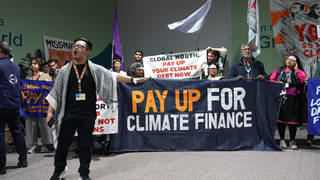
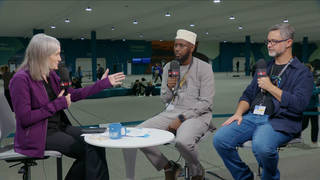
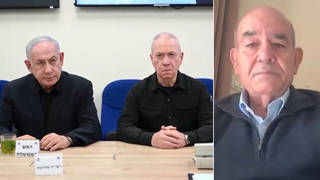
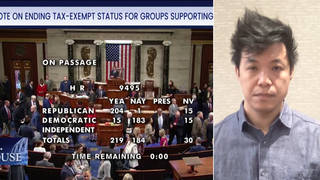
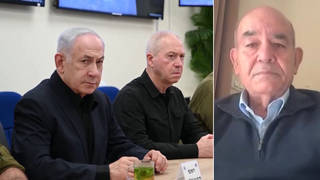




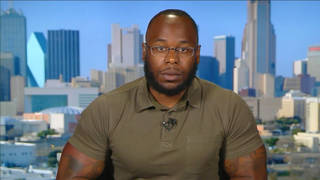
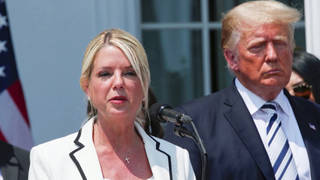
Media Options